Expanded Goodman Sextets with Christian
Aside from his Swing orchestra, the combos generated a substantial body of work. And in practice, the so-called Benny Goodman Sextet grew to seven or eight pieces. Sessions that amounted to studio jam sessions were a superb platform for the inspiring encounters with brilliant artistic peers that Benny sought and craved.
Lineups for the Sextet recordings fluctuated as he cycled through a dizzying roster of top-notch musicians, hiring the finest virtuosi at the cutting edge of jazz. Musicians heard on Sextet records include: piano players Count Basie, Johnny Guarneri and Mel Powell; saxophonists Johnny Hodges, Georgie Auld and Lester Young; vocalist Peggy Lee; trumpet players Buck Clayton and plunger-mute master Cootie Williams and drummers Dave Tough and Nick Fatool.
In fact, the startling move of trumpeter Cootie Williams (1911–1985) to Goodman after a decade with Duke Ellington was recounted breathlessly by the music press and cause for a popular tune written by Raymond Scott: “When Cootie Left the Duke.” Inspired by Goodman’s success with small groups, big band leaders such as Count Basie, Duke Ellington, Artie Shaw, John Kirby and Raymond Scott continued to feature combos drawn from the larger bands on live performances as well as recording sessions.
Clip – BG Sextet Pt 3 – Basie, Cootie Williams
Professional Classical Virtuoso
Clip – Benny’s Classical Career
Surprisingly, in order to develop greater interpretive range and character, Benny began studying classical clarinet technique in earnest before 1940. He had high aspirations, worked very hard, and achieved broad proficiency in the clarinet literature of symphonic concertos and chamber music of Mozart, Brahms, Weber, Stravinsky, Bartok and Debussy.
Formal training and developing “classical embouchure” yielded long-term benefits, aiding him in retaining extraordinary strength and flexibility in the muscles of his mouth late into life. However, by most accounts he never became a great classical clarinet soloist.
The elevated level to which Goodman aspired required more than technical excellence. Ironically, what was missing from his classical performance was “flow.” The same relaxation and spontaneity that had made Benny such an exquisite jazz musician seems to have eluded him in the symphony hall.
Nevertheless, aided by his vast talent, fame, drive and discipline, Goodman eventually performed or recorded with most of the major American orchestras. He commissioned numerous works from celebrated American composers Aaron Copland, Paul Hindemith, Morton Gould and others.
Premiered by Benny in 1955, “Derivations for Clarinet and Band” grew out of Gould’s long association with Goodman dating back to the Thirties, as he “tried to simulate certain ‘Benny-oriented’ patterns or trademarks.” Heard performing the opening and closing movements is John Bruce Yeh, recorded by Professor Keith Johnson for Reference Recordings (RR-53CD, 1991).
Morton Gould, Derivations: Warmup
Morton Gould, Derivations: Rideout
Challenging Racism in the Music Industry
Goodman hired the artists he wanted to work with; if they happened to be African-American he wouldn’t let institutional bigotry stop him. As Benny put it, “I’m selling music, not prejudice.” He sought musicians his equal in creativity and skill regardless of their race, choosing African American artists Teddy Wilson, Lionel Hampton, Charlie Christian and others.
He didn’t set out to challenge racial segregation in the music industry. Goodman wasn’t politically radical, but Goodman was a radical musician with enough commercial clout to violate the racist practices of the record industry.
In practice, there never were any racial incidents resulting from his inclusion of African American musician on records or in touring ensembles, even in the Southern United States. That said, the sidemen in question were never officially members of his band but presented as special guests. Still, wide social acceptance of Goodman’s chosen musical partners demonstrated that music could transcend the divisions of a segregated nation.
Clip – Goodman_with_Strings_1950s
Critics and Criticism
Much criticism and many harsh assessments have been directed at Goodman and his music — some valid, most not. More than one commentator have suggested that Goodman was a Caucasian musician who appropriated the music invented by African-Americans for his own benefit, exploiting and popularizing a bland hybrid for a mainstream white audience.
These accusations are false on several counts. No single ethnic group invented nor owns Jazz. It was an interracial music from its origins in the unique blend of ethnic, social and cultural conditions in turn-of-the-century New Orleans. And in practice, musicians themselves rarely discriminated by race.
In truth, few professional musicians of Goodman’s stature did more to defy longstanding racism in the music industry. He blunted racial division by bringing African American musicians into his combos, concerts and touring bands before 1940. And though Goodman catered to a popular audience, his music always contained unmistakable jazz elements and presented strong improvisors.
Clip – 1950s from the Yale Collection, No Way to Stop It, How High the Moon
An Immense Cultural Legacy
In the 1970s Goodman developed a strong affiliation with Yale University where he taught, conducted seminars and received an honorary doctorate. Months before his death in 1986, Benny donated his voluminous personal collection to the Yale University Music Library, including his memorabilia, papers, 5,000 photographs, 1,500 arrangements, scrapbooks, awards and clippings.
To Yale he also donated hundreds of audiotapes and the right to publish previously unreleased recordings. The Benny Goodman Yale Library project has subsequently issued some dozen fascinating volumes that are intermittently available on CD, vinyl or streaming services, offering a historical and stylistic cross-section of his works.
Through his vast talent, enterprise, focus and creativity, Benny Goodman shaped the Swing era and gave the clarinet a newly assertive leadership role in the jazz ensemble. His trios, quartets and combos shaped a forward-leaning chamber music Jazz, while opening the eyes and ears of a racially divided culture. Launching, defining and refining the Swing era, Benjamin David Goodman won lasting admiration for his monumental contributions to 20th Century American culture.
Clip – Sing Sing Sing.mp3
Encore: Herb Caen’s Birthday Album
A limited-edition album was distributed to celebrate the 1976 birthday of a noted Goodman enthusiast . . . San Francisco newspaper columnist Herb Caen. Recorded at his 60th birthday party, personnel include the late Jack Sheldon (trumpet), Lou Levy (piano) and Louie Bellson (drums). Only 100 copies of this vinyl record were issued under the tongue-in-cheek marque: Co Lector Situm.
Avalon – Caen Party, 1976
Seven Come Eleven – Caen Party, 1976
Sources and further reading:
Benny Goodman, Giants of Jazz [box set liner notes], Philip W. Payne (Time-Life, 1979)
The New Grove Dictionary of Jazz 2nd Ed., Barry Kernfeld editor (Macmillan, 2002)
Jazz Records 1897-42 [discography], Brian Rust (Arlington House, 1978)
Great thanks to Hal Smith for music consultation and assistance.
LINKS:
An excellent Goodman tribute site https://www.bennygoodman.com/
Benny Goodman on Jazz Rhythm http://www.jazzhotbigstep.com/45801.html
Charlie Christian on Jazz Rhythm http://www.jazzhotbigstep.com/79001.html
- ← Previous page
- (Page 2 of 2)

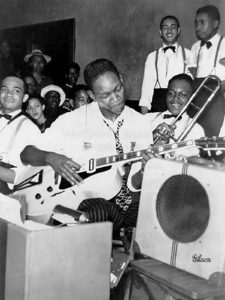
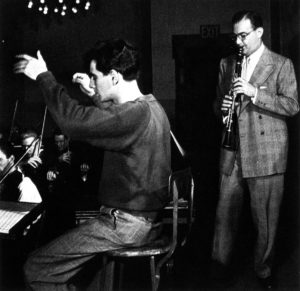
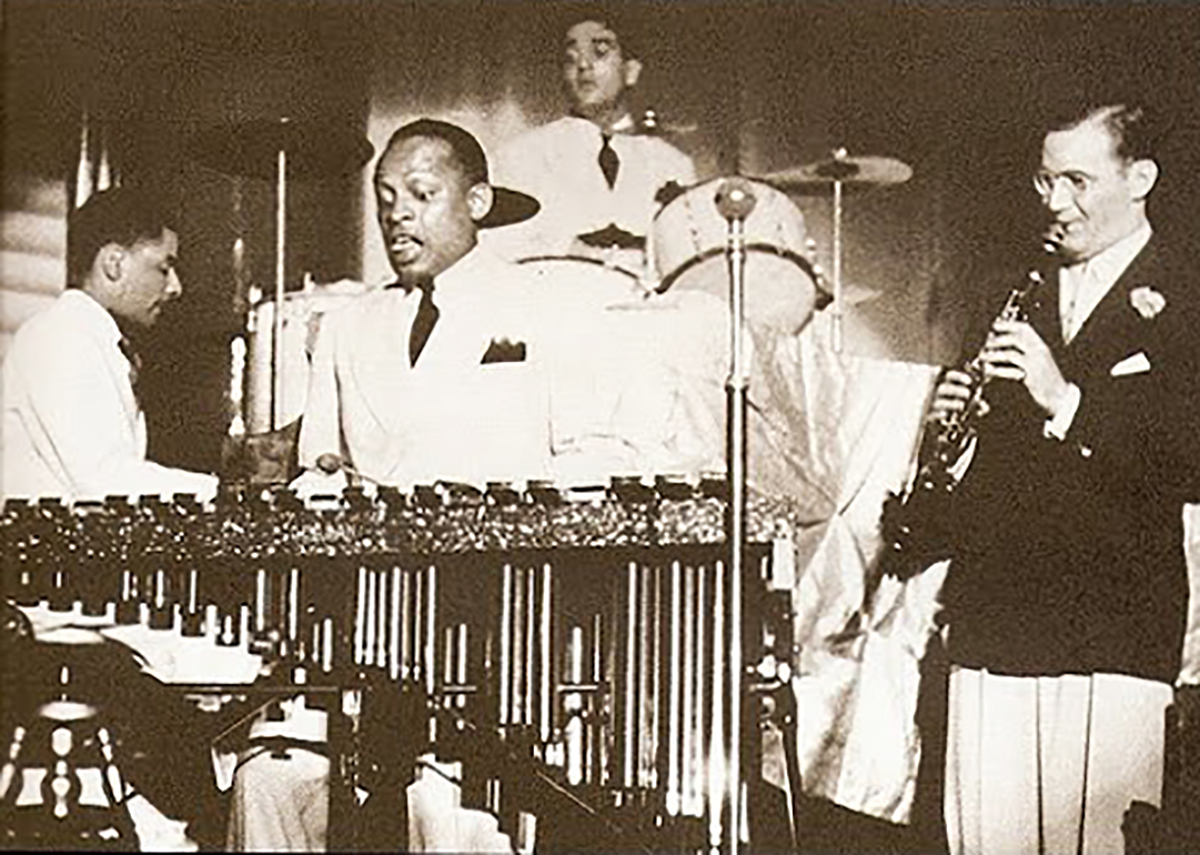
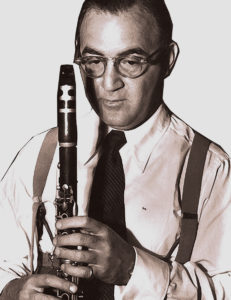
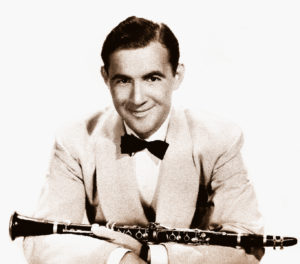
Thanks so much for these columns. Great background material on one of jazz’s greatest artists. I think his recording of Sing!Sing!Sing! featuring Harry James and Gene Krupa is the best rockandroll recording ever made.